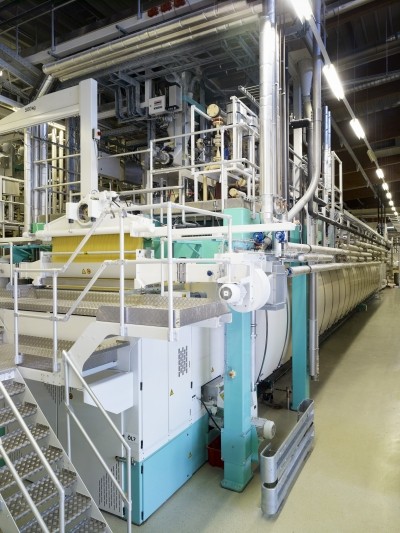Buhler targets growth in pasta segment
bigger share of the growing market for pasta-making machines.
Switzerland-based Buhler is making a renewed bid to capture a bigger share of the growing market for pasta-making machines.
The company is looking at developing new techniques and equipment for the segment, targeting an expansion from dry pasta making into nutrition, gluten free products and Korean-style noodles.
Beat Müller, head of the segment since January 2004, said the company has not been focused enough in the past on developing its pasta processing market.
Now its pasta business unit is attempting to exploit the current upswing in the pasta market.
“It is true, for some time, we failed to focus adequately on customers’ needs in the development of new products,” Müller stated.
“But that is now definitely a thing of the past.
We have exceeded our targets in fiscal 2004 and are also on track in 2005.
We have overcome the phase of stagnation.
This has only been possible because we called to mind the most important strengths of Buhler and moved back closer to our customers and their requirements.”
Detlef Janssen, spokesman for Buhler, told FoodProductionDaily.com that the company plans to devote about five per cent of its sales revenues to research and development for the segment.
Buhler's pasta unit currently contributes to about seven per cent of the group's overall sales.
Buhler had sales revenue of €933 million in 2004.
Janssen says estimates put the growth rate of Europe's pasta processing industry at an average of between two to three per cent each year in the three years to 2004.
Buhler installed its first dry pasta production lines in 1903 and so far has about a 40 per cent share of the market.
The company's market share is in part based on what Müller says is its innovative dough preparation system.
“Our enclosed system ensures top sanitation standards in dough preparation,” Müller stated.
He said a certain lack of flexibility in meeting customers’ requirements led to a temporary stagnation of the unit at the end of the nineties.
“We have changed our attitudes,” he stated.
“Our customers want to supply their own customers with topquality pasta.
But end consumers’ needs are changing continuously according to fashion.
Therefore, it is our task to offer our customers the best possible solutions in the form of processes and equipment enabling them to satisfy their own customers’ ever changing needs.”
However he cautions that the potential for growth of the Buhler pasta business unit is limited.
“Pasta is an inexpensive food with a long shelf life.
As a result, pasta consumption will expand from traditional markets to new market segments," he stated.
"It is needless to say that we plan to be a major player also when it comes to developing these new markets.
But we must also open up new market segments if we want to sustain healthy growth over the next few years.”
The increasing consumer demand for more nutritional products is one area the company hopes to continue expanding into.
The company recently developed a process allowing glutenfree pasta to be produced from corn or rice.
Corn and rice allows people suffering from celiac disease, those with an inability to absorb gluten, to enjoy the pasta despite their disorder.
A similar health-related effort is being made to develop processes for improving the production of wholegrain pasta.
So far, Buhler's strategy in the market has been to deliberately limit its activities to the manufacture of production lines for making dry pasta.
“But why shouldn’t we also get into other markets,” Müller stated.
“Though it is true that we have not yet accumulated much specific knowledge in the production of Asian noodles, we plan to enter this large market in the future.
We have already commissioned initial studies to this end.”
A total of 55 persons work for the Buhler's pasta business unit in Uzwil.
They are engaged in sales and engineering, customer service and laboratory analyses.
Seven additional staff members support customers in local Buhler organizations in the most important pasta markets.
All pasta plant and equipment are manufactured in the centralized Buhler factory.
The road into the future appears to be clear for the Buhler Pasta business unit.
Unit manager Beat Müller, at least, is very confident: “We have achieved our first goal – the turnaround," Müller stated.
"Now, we will stabilise our earnings situation, develop new regional markets, and identify and enter new market segments."
Statistics from the Union of Organisations of Manufacturers of Pasta Products in the EU show that pasta production in the bloc rose to 4.11 million tonnes in 2004 from 3.95 million tonnes in 2003.
Demand rose to 3.12 million tonnes from 3.03 million tonnes during the same period.
The processing industry has consolidated down to 198 companies in 2004 compared to 248 enterprises in 1993.
Union of Organisations of Manufacturers of Pasta Products in the EU (1993-2004) 1993 1998 2003 2004* Number of companies 248 215 210 198 Employees 15.930 12.890 13.713 11.745 Production (tonnes)
3.455.571 3.875.982 3.965.795 4.106.375 Demand (tonnes)
2.439.845 2.992.778 3.030.259 3.121.414 (*) Data includes: Austria,, France, Germany, Greece, Italy, Portugal, Spain, Sweden (2003) and the United Kingdom








